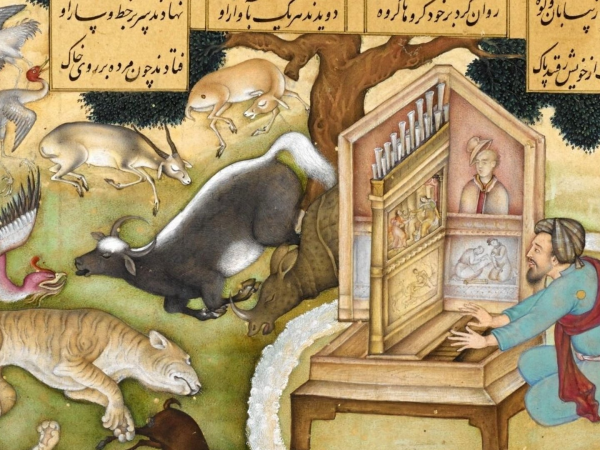Persian Miniature Painting: Plato Charms the Animals
As the story goes, a competition took place between two great Greek philosophers, Plato and Aristotle, to decide who was the wisest. Aristotle began by boasting that he possessed all earthly knowledge. In response, Plato listened to the music of the spheres and stars, then created a musical instrument unlike any seen before. When Plato drew a circle around himself and played this instrument, its sounds were so harmonious and perfect that animals around him—predator and prey alike—fell into a hypnotic swoon. Afterwards, Plato played another tune to wake them. The animals, now refreshed, continued on their way.
This astonishing scene is not mentioned in Greek epics. Instead, it is found in the Khamsa of Nizami, in Nizami's account of Alexander the Great (Iskandar). Aristotle, chastened by his loss, eventually accepts Plato as the true master. This is in line with the rise of Neoplatonism and Sufism in Persia at the time.
In this course, we will paint inspired by Plato’s charming and waking the animals - focus and reflect, and then emerge, refreshed by beauty and harmony.
The pleasure of concentrating on a single miniature for a period of time involves us deeply. We are immersed in it; we live with it; we live in it. Inhabiting and internalising a painting in this way is a wonderful and traditional way to learn. In today’s fast-paced world we need to sit, focus on and contemplate our single piece and grow to love and understand it. We will understand the subtle art of colour, composition and blending by our action of making and doing, connecting with the work. The aim is not to rush, but to dwell. Thus painting is a form of meditation in itself.
Students are invited to recreate this miniature painting alongside the tutor, incorporate elements into existing work or be inspired to create their own compositions. Lions, tigers, and antelopes lie in repose, allowing us to see and paint their soft bellies and draw them in positions we don't normally find in miniature painting.
Booking Options
As the story goes, a competition took place between two great Greek philosophers, Plato and Aristotle, to decide who was the wisest. Aristotle began by boasting that he possessed all earthly knowledge. In response, Plato listened to the music of the spheres and stars, then created a musical instrument unlike any seen before. When Plato drew a circle around himself and played this instrument, its sounds were so harmonious and perfect that animals around him—predator and prey alike—fell into a hypnotic swoon. Afterwards, Plato played another tune to wake them. The animals, now refreshed, continued on their way.
This astonishing scene is not mentioned in Greek epics. Instead, it is found in the Khamsa of Nizami, in Nizami's account of Alexander the Great (Iskandar). Aristotle, chastened by his loss, eventually accepts Plato as the true master. This is in line with the rise of Neoplatonism and Sufism in Persia at the time.
In this course, we will paint inspired by Plato’s charming and waking the animals - focus and reflect, and then emerge, refreshed by beauty and harmony.
The pleasure of concentrating on a single miniature for a period of time involves us deeply. We are immersed in it; we live with it; we live in it. Inhabiting and internalising a painting in this way is a wonderful and traditional way to learn. In today’s fast-paced world we need to sit, focus on and contemplate our single piece and grow to love and understand it. We will understand the subtle art of colour, composition and blending by our action of making and doing, connecting with the work. The aim is not to rush, but to dwell. Thus painting is a form of meditation in itself.
Students are invited to recreate this miniature painting alongside the tutor, incorporate elements into existing work or be inspired to create their own compositions. Lions, tigers, and antelopes lie in repose, allowing us to see and paint their soft bellies and draw them in positions we don't normally find in miniature painting.


